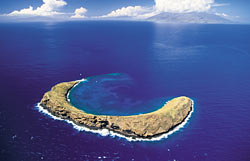Formation of Molokini Crater
The offshore crater was created by undersea volcanic eruptions.
Many thousands of years ago, deep on the ocean floor not far from the island of Maui, a volcano began to erupt. This undersea volcano was located along Haleakala Volcano's southwest rift zone. After millennia of eruptions this undersea volcano finally rose above the surface.
When the volcano's peak erupted above the water it shot rocks and cinder into the air. The result of all of these eruptions is the Molokini Crater we know today, which is one of the best diving spots on the planet.
The summit crater of Molokini is thought to have formed relatively early in the life of Haleakala Volcano, and may be older than Haleakala's summit which reaches 10,000 feet above sea level.
Now rising above the sea is just the summit of a huge undersea volcanic mountain, more properly known in geologic terms as a cinder cone. The cone rises about 500 feet from the flank of Haleakala Volcano.
Eventually this active cinder cone, which, had finally risen above the ocean's surface, ceased to erupt lava. Only the crater of Molokini now remains protruding above the sea.
The half-submerged summit crater of Molokini stands 160 feet above sea level. The crescent-moon shaped crater creates a welcoming area for scuba divers and snorkelers as well as a thriving habitat for native Hawaiian birds, fish, and other marine species.
While there are many cinder cones found on the ocean floor around the Hawaiian Islands, it is rare for a cinder cone to grow tall enough to rise above the ocean's surface like Molokini. The last eruption is thought to have occurred about 230,000 years ago.



